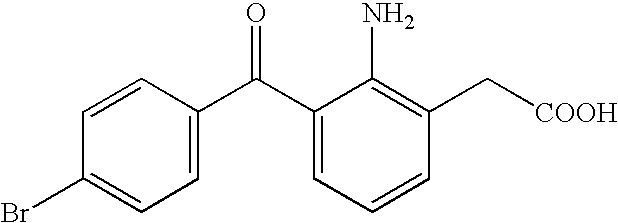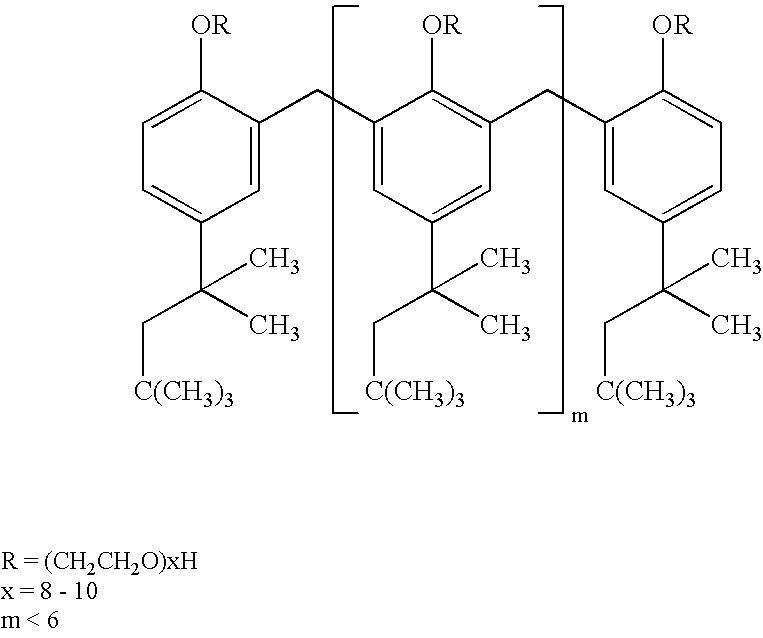Bromfenac ophthalmic formulations and methods of use
a technology of bromfenac and ophthalmic composition, which is applied in the field of bromfenac ophthalmic formulation and method of use, can solve the problems of incompatibility of benzalkonium chloride and other quaternary ammonium compounds with ophthalmic composition, topical corticosteroids are also known to slow or delay healing, so as to reduce the preservative
- Summary
- Abstract
- Description
- Claims
- Application Information
AI Technical Summary
Benefits of technology
Problems solved by technology
Method used
Image
Examples
experimental example 1
Stability Test of Sodium 2-amino-3-(4-bromobenzoyl)phenylacetate
[0147] Four eye drops of sodium 2-amino-3-(4-bromobenzoyl)phenylacetate comprising the components as shown in Table 1 were prepared, filled respectively into a polypropylene container and subjected to stability test at 60.degree. C.
TABLE 1ComparisonComponentExample 1A-01A-02A-03Sodium 2-amino-3-(4-0.1 g0.1 g0.1 g0.1 gbromobenzoyl)phenyl-acetateBoric acid1.5 g1.5 g1.5 g1.5 gBenzalkonium chloride0.005 g 0.005 g 0.005 g 0.005 g Polysorbate 800.15 g ———Polyoxyl 40 stearate—0.15 g ——Tyloxapol——0.15 g 0.02 g Sterile purified waterq.s.q.s.q.s.q.sTotal volume 100 mL 100 mL 100 mL 100 mLpH7.07.07.07.0Remaining rate51.3 63.7 73.8 89.6 (%) at 60° C.after 4 weeks
[0148] The remaining rate (%) in the above Table 1 indicates values obtained by correcting moisture vaporization from the container. As is apparent from the Table 1, stability test was carried out under the conditions of pH 7.0 at 60° C. for 4 weeks, and sodium 2-amino-3...
experimental example 2
Stability Test of Sodium 2-amino-3-(4-bromobenzoyl)phenylacetate
[0150] Five eye drops of sodium 2-amino-3-(4-bromobenzoyl)phenylacetate comprising the components as shown in Table 2 were prepared, filled respectively into a polypropylene container and preserved at 60.degree. C. for 4 weeks, and then the content of 2-amino-3-(4-bromobenzoyl)phenylacetic acid and the pH in each eye drop were measured.
TABLE 2ComponentsA-04A-05A-06A-07A-08Sodium 2-amino-3-(4-0.1 g0.1 g0.1 g0.1 g0.1 gbromobenzoyl)phenylacetateBoric acid1.1 g1.1 g1.1 g1.1 g1.1 gBorax1.1 g1.1 g1.1 g1.1 g1.1 gBenzalkonium chloride0.005 g 0.005 g 0.005 g 0.005 g 0.005 g Polysorbate 80—————Tyloxapol0.02 g 0.05 g 0.03 g ——Polyoxyl 40 stearate———0.02 g 0.05 g Polyvinylpyrrolidone (K-30)2.0 g2.0 g2.0 g2.0 g1.0 gSodium edetate0.02 g 0.02 g 0.02 g 0.02 g 0.02 g Sodium hydroxideq.s.q.s.q.s.q.s.q.s.Sterile purified waterq.s.q.s.q.s.q.s.q.s.Total volume 100 mL 100 mL 100 mL 100 mL 100 mLpH8.178.168.158.198.1960° C.,Remaining rate ...
experimental example 3
Preservative Effect Test of Aqueous Liquid Preparation Containing Sodium 2-amino-3-(4-bromobenzoyl)phenylacetate
[0152] Preservative effect test of compositions A-04, A-05 and A-07 of Experimental Example 2 was carried out against Staphylococcus aureus (hereinafter referred to as S. aureus), Escherichia Coli (hereinafter referred to as E. coli), Pseudomonas aeruginosa (hereinafter referred to as P. aeruginosa), Candida albicans (hereinafter referred to as C. albicans) and Aspergillus niger (hereinafter referred to as A. niger).
[0153] The results are shown in Tables 3-1, 3-2 and 3-3.
[0154] Table 3-1
TABLE 3-1Cell count (CFU / mL)6 hours24 hours7 days14 days21 days28 daysInoculumafterafterafterafterafterafterA-04countinoculationinoculationinoculationinoculationinoculationinoculationS. aureus2.1 × 1063.0 × 10100000E. coli6.5 × 106000000P. aeruginosa5.8 × 106000000C. albicans3.2 × 105——0000A. niger1.8 × 105——0000
[0155] Table 3-2
TABLE 3-2Cell count (CFU / mL)6 hours24 hours7 days14 days21...
PUM
 Login to View More
Login to View More Abstract
Description
Claims
Application Information
 Login to View More
Login to View More - R&D
- Intellectual Property
- Life Sciences
- Materials
- Tech Scout
- Unparalleled Data Quality
- Higher Quality Content
- 60% Fewer Hallucinations
Browse by: Latest US Patents, China's latest patents, Technical Efficacy Thesaurus, Application Domain, Technology Topic, Popular Technical Reports.
© 2025 PatSnap. All rights reserved.Legal|Privacy policy|Modern Slavery Act Transparency Statement|Sitemap|About US| Contact US: help@patsnap.com


